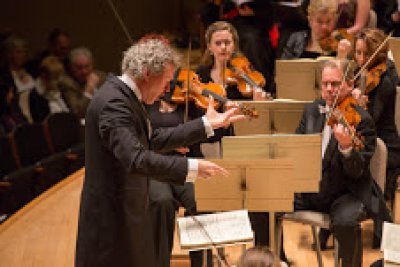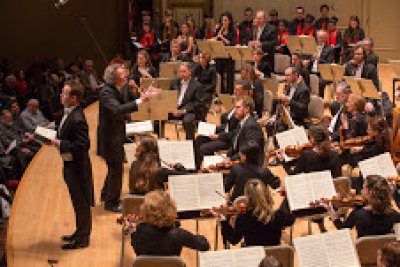Handel and Haydn Society: Bach’s “St. Matthew Passion”
A beautifully performed work of genius highlights Boston's unique place in American and international classical music performance.

Handel + Haydn Artistic Director Harry Christophers leads the Period Instrument Orchestra and Chorus, the Vocal Arts Program Young Women’s Chamber Choir and the Young Men’s Choir (Photo credit: James Doyle)
[avatar user=”Jean Ballard Terepka” size=”96″ align=”left” ] Jean Ballard Terepka, Music Critic[/avatar] As part of their splendid yearlong Bicentennial Celebrations, the Handel and Haydn Society of Boston have been presenting major choral works that have figured prominently in the Society’s long distinguished history. In March 2015, in the very depths of Lent, the featured work was Bach’s extraordinary St. Matthew Passion. Any successful performance of this monumental work demands elegant artistic discipline and a coherent intellectual and creative vision; the Handel + Haydn Society’s Artistic Director and Conductor, Harry Christophers, the Handel + Haydn Society Period Instrument Orchestra and Chorus, the six wonderful soloists, and the Vocal Arts Program Young Women’s Chamber Choir and Young Men’s Chorus all effectively brought the necessary rigorous musicianship and artistic clarity to this performance. The result was indeed wonderful.
Christophers’ St. Matthew Passion was lucid and compelling. The long work contains music of all kinds, each with its own individual challenges. There is singing for sometimes one chorus and sometimes both; for single soloists, soloists singing in pairs, soloists singing in dialogue and conversation with individual instrumentalists in the orchestra; for sections of the orchestra, for two small orchestras or one big orchestra. The order and architecture of all these elements illuminate the sacred text, at once unique and universal, that carries the story of Jesus’ betrayal and crucifixion.
Christophers managed all these elements with deft control, enabling each to be presented with its own particular strengths and joining them all together to present a coherent theological and musical whole. The work’s conclusion, the astonishing last chorus, whose beauty reveals the cardinal Christian mystery – that from Jesus’ death eternal life emerges – came as a gorgeous and fully energetic inevitability.
The soloists – Joshua Ellicott, tenor/Evangelist; Roderick Williams, baritone/Jesus; Joelle Harvey, soprano; Anna Stephany, mezzo-soprano; Matthew Long, tenor; and Sumner Thompson, baritone – were marvelous. Harvey, Stephany, Long and Thompson all managed to differentiate recitatives and arias that contributed to the forward-moving narrative of the Passion story from those that give voice to the Israelites’ anguish at the execution of their Jesus, and ours.
Ellicott and Williams were particularly fine. Over the course of the evening, both grew into the full psychological richness of their roles. Ellicott as the Evangelist, in particular, gave a moving performance as the reporter of events who simultaneously becomes an anonymous companion to Jesus in his terrible progress towards execution and an embodiment of our own response to the unfolding story.
The Handel + Haydn Society Orchestra’s use of period instruments, those of Bach’s time, reveals in their sound the intimate nuances of Bach’s inventiveness in ways that modern instruments cannot: gut and reed are closer to our own known selves than steel and plastic. The sound of Bach’s music on these Baroque instruments is warmer, no less intellectually elegant, and closer to serenity when serenity is called for. These qualities were all in evidence in this performance.
The strengths of the performance – its subtleties and nuance, its intimacy even within its power – were, paradoxically, sometimes in peril of being lost.

Tenor Matthew Long and Handel + Haydn Artistic Director Harry Christophers conducting the Period Instrument Orchestra and Chorus, the Vocal Arts Program Young Women’s Chamber Choir and the Young Men’s Choir (Photo credit: James Doyle)
Boston Symphony Hall, though modeled architecturally and acoustically on an eighteenth century hall in Leipzig, was designed for bigness and public grandeur.
But it is not the kind of space that Bach wrote his Passion for.
Bach wrote for churches. This long, long Passion – with a lengthy, important sermon between Part I and Part I – was first performed on Good Friday, April 11, 1727, in the Leipzig church where Bach was in his fourth year as chief musician. On that April day, in that sacred space, occasion and site would have made each subtlety and detail of interconnected word and music audible to all those who would listen.
The Handel + Haydn Society’s introduction of the St. Matthew Passion to America was something very different from what Bach would have imagined or even recognized. When the Society first presented the work in May, 1871, it was an incomplete Passion that Bostonians heard: only about one third of the work was actually performed. And it was big: there were 700 singers and 100 in the orchestra. It was the choruses and chorales that astonished the audience. One reviewer noted that one chorus, Ye Lightnings, Ye Thunders (Sind Blitze, sind Donner) startled the audience, “and it was a followed by a storm of applause and demand for repetition. It showed how easily Bach could handle the dramatic element he so minded.”
As the popularity of Bach’s St. Matthew Passion continued to grow, in both Europe and the United States, huge musical forces were deployed in huge public musical spaces to perform it throughout at least the first half of the twentieth century.
But, in good company with musicians and performers who initiated the development of historicallyinformed Baroque music throughout the 1970’s and early 1980’s, the Handel + Haydn Society took on a new course beginning in 1986, when, under the leadership of Christopher Hogwood, the orchestra became a period instrument orchestra. Christophers, who has been the Society’s Artistic Director since 2009, now continues in the tradition Hogwood set, and has led the Society to new twenty-first century visibility and popularity.
But the sound of the period instruments – earthier, reedier, sweeter and more vulnerably intimate – than the sound of modern instruments can be lost in a big hall and the voices of soloists trained to work in partnership with the period instruments can sound thin or faint.
So, on March 27, 2015, in the big Boston Symphony Hall, filled to capacity by the Handel + Haydn Bicentennial successes, some fine elements of the St. Matthew Passion performance were endangered: in part I, for instance, Stephany’s recitatives and arias were somewhat difficult to hear, especially in the lower registers. Occasionally, the bravura of the orchestral writing was muted by the huge space: the delicate musical lines of principle instruments, especially when set against several sections, could be hard to detect.
These minor difficulties, however, did not mar a wonderful performance. The cumulative power of the work – Bach’s, and Christophers’, and the musicians’ in service to Bach – was thrilling; the final magnificent chorus was an affirmation of Bach, the achievements and identity of the Handel + Haydn Society, and the desire of the Boston audience to hear both.
Handel + Haydn Society: Bach’s “St. Matthew Passion” (March 27, 2015)
Boston Symphony Hall, 301 Massachusetts Avenue, in Boston
For information: visit http://www.handelandhaydn.org
Running time: two and a half hours with one intermission






Leave a comment